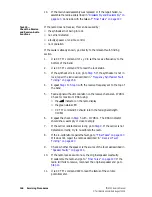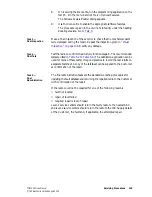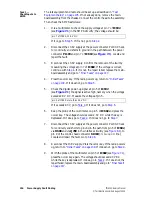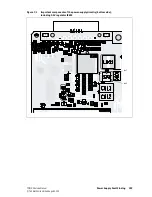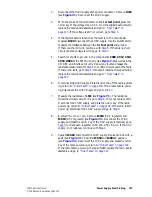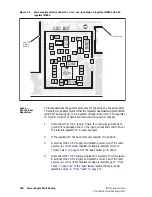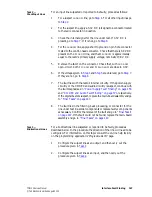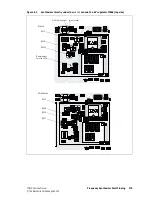
160
Power Supply Fault Finding
TM9100 Service Manual
© Tait Electronics Limited
August 2005
Task 5 —
Check Power-up
Options
The functioning of the power-up options may be checked as described in
Step 1
to
Step 4
below. Carry out the procedure in the appropriate step or
steps. In all four cases the procedure involves checking the digital power-up
signal at pin 5 of IC602. For a particular option, the activation mechanism
is the condition that results in the power-up signal becoming active (the
signal is active high).
1.
For the battery power-sense option the link LK1 should be inserted
(see
Figure 7.2
). Check the power-up signal at pin 5 of IC602
(see
Figure 7.1
) while first disconnecting and then reconnecting the
13.8V DC supply at the power connector.
The power-up signal should go high when the power is reconnected.
If it does, conclude with
Step 5
. If it does not, check for continuity
and shorts to ground between the link LK1 and the
+13
V
8
BATT
input
at the power connector PL100. Repair any fault and go to
Step 5
.
2.
For the auxiliary power-sense option the link LK2 should be inserted
(see
Figure 7.2
). C3.3 V DC (more than 2.6 V to be
precise) from the power supply to the
AUX GPI
3
line (pin 4 of the
auxiliary connector SK101). Check that the power-up signal at pin 5
of IC602 (see
Figure 7.1
) is high.
Remove the +3.3V supply and ground the
AUX GPI
3
line (to be precise
the voltage on the line should be less than 0.6 V). If the power-up
signal is now low, conclude with
Step 5
. If it is not, check for
continuity and shorts to ground between D601 (see
Figure 7.1
) and
pin 4 of the auxiliary connector SK101. Repair any fault and go to
Step 5
.
3.
For the emergency power-sense option the link LK3 should be
inserted (see
Figure 7.2
). Connect the
AUX GPI
2
line (pin 5 of the
auxiliary connector SK101) to ground. Check that the power-up
signal at pin 5 of IC602 (see
Figure 7.1
) is high.
Remove the connection to ground. If the power-up signal is now
low, conclude with
Step 5
. If it is not, check for continuity and shorts
to ground in the path from D601 (see
Figure 7.1
), via Q600
(see
Figure 7.2
), to pin 5 of the auxiliary connector SK101. Repair
any fault and go to
Step 5
.
Summary of Contents for TM9100
Page 1: ...TM9100 mobiles Service Manual MMA 00017 01 Issue 1 August 2005 ...
Page 4: ...4 TM9100 Service Manual Tait Electronics Limited August 2005 ...
Page 10: ...10 TM9100 Service Manual Tait Electronics Limited August 2005 ...
Page 22: ...22 Introduction TM9100 Service Manual Tait Electronics Limited August 2005 ...
Page 62: ...62 Description TM9100 Service Manual Tait Electronics Limited August 2005 ...
Page 96: ...96 TM9100 Service Manual Tait Electronics Limited August 2005 ...
Page 138: ...138 Disassembly and Reassembly TM9100 Service Manual Tait Electronics Limited August 2005 ...
Page 152: ...152 Servicing Procedures TM9100 Service Manual Tait Electronics Limited August 2005 ...
Page 168: ...168 Interface Fault Finding TM9100 Service Manual Tait Electronics Limited August 2005 ...
Page 244: ...244 Receiver Fault Finding TM9100 Service Manual Tait Electronics Limited August 2005 ...
Page 396: ...396 CODEC and Audio Fault Finding TM9100 Service Manual Tait Electronics Limited August 2005 ...
Page 420: ...420 Fault Finding of Control Head TM9100 Service Manual Tait Electronics Limited August 2005 ...
Page 426: ...426 Spare Parts TM9100 Service Manual Tait Electronics Limited August 2005 ...
Page 430: ...430 TM9100 Service Manual Tait Electronics Limited August 2005 ...
Page 444: ...444 TMAA04 05 Ignition Sense Kit TM9100 Service Manual Tait Electronics Limited August 2005 ...
Page 448: ...448 TMAA10 01 Desktop Microphone TM9100 Service Manual Tait Electronics Limited August 2005 ...

